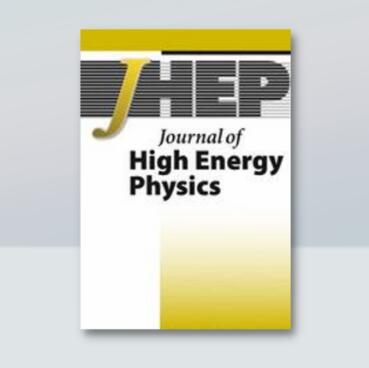New horizons for inhomogeneous quenches and Floquet CFT
IF 5.4
1区 物理与天体物理
Q1 Physics and Astronomy
引用次数: 0
Abstract
A fruitful avenue in investigating out-of-equilibrium quantum many-body systems is to abruptly change their Hamiltonian and study the subsequent evolution of their quantum state. If this is done once, the setup is called a quench, while if it is done periodically, it is called Floquet driving. We consider the solvable setup of a two-dimensional CFT driven by Hamiltonians built out of conformal symmetry generators: in this case, the quantum dynamics can be understood using two-dimensional geometry. We investigate how the dynamics is reflected in the holographic dual three-dimensional spacetime and find new horizons. We argue that bulk operators behind the new horizons are reconstructable by virtue of modular flow.
求助全文
约1分钟内获得全文
求助全文
来源期刊

Journal of High Energy Physics
物理-物理:粒子与场物理
CiteScore
10.30
自引率
46.30%
发文量
2107
审稿时长
1.5 months
期刊介绍:
The aim of the Journal of High Energy Physics (JHEP) is to ensure fast and efficient online publication tools to the scientific community, while keeping that community in charge of every aspect of the peer-review and publication process in order to ensure the highest quality standards in the journal.
Consequently, the Advisory and Editorial Boards, composed of distinguished, active scientists in the field, jointly establish with the Scientific Director the journal''s scientific policy and ensure the scientific quality of accepted articles.
JHEP presently encompasses the following areas of theoretical and experimental physics:
Collider Physics
Underground and Large Array Physics
Quantum Field Theory
Gauge Field Theories
Symmetries
String and Brane Theory
General Relativity and Gravitation
Supersymmetry
Mathematical Methods of Physics
Mostly Solvable Models
Astroparticles
Statistical Field Theories
Mostly Weak Interactions
Mostly Strong Interactions
Quantum Field Theory (phenomenology)
Strings and Branes
Phenomenological Aspects of Supersymmetry
Mostly Strong Interactions (phenomenology).
 求助内容:
求助内容: 应助结果提醒方式:
应助结果提醒方式:


